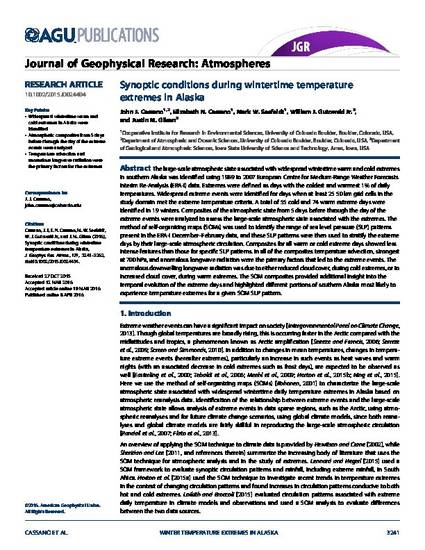
The large-scale atmospheric state associated with widespread wintertime warm and cold extremes in southern Alaska was identified using 1989 to 2007 European Centre for Medium-Range Weather Forecasts Interim Re-Analysis (ERA-I) data. Extremes were defined as days with the coldest and warmest 1% of daily temperatures. Widespread extreme events were identified for days when at least 25 50 km grid cells in the study domain met the extreme temperature criteria. A total of 55 cold and 74 warm extreme days were identified in 19 winters. Composites of the atmospheric state from 5 days before through the day of the extreme events were analyzed to assess the large-scale atmospheric state associated with the extremes. The method of self-organizing maps (SOMs) was used to identify the range of sea level pressure (SLP) patterns present in the ERA-I December–February data, and these SLP patterns were then used to stratify the extreme days by their large-scale atmospheric circulation. Composites for all warm or cold extreme days showed less intense features than those for specific SLP patterns. In all of the composites temperature advection, strongest at 700 hPa, and anomalous longwave radiation were the primary factors that led to the extreme events. The anomalous downwelling longwave radiation was due to either reduced cloud cover, during cold extremes, or to increased cloud cover, during warm extremes. The SOM composites provided additional insight into the temporal evolution of the extreme days and highlighted different portions of southern Alaska most likely to experience temperature extremes for a given SOM SLP pattern.
Available at: http://works.bepress.com/william-gutowski/60/

This article is from Journal of Geophysical Research: Atmospheres 121 (2016): 3241-3262, doi:10.1002/2015JD024404. Posted with permission.